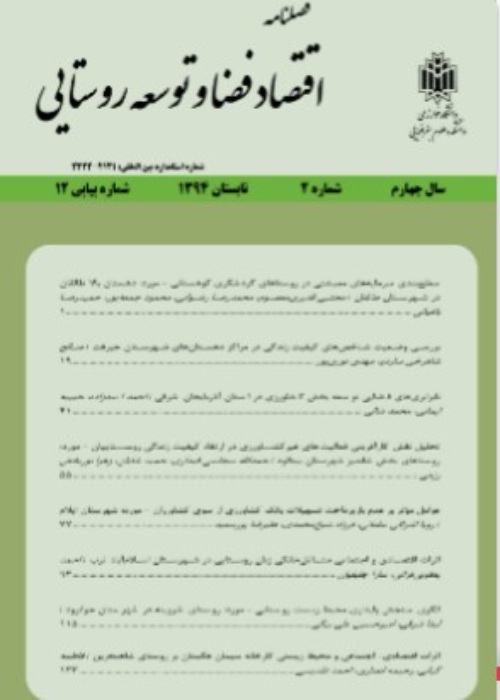Requirements for achieving sustainable entrepreneurship in the coastal villages located in south of Qeshm Island
Rural areas in the country, today, suffer from myriad challenges such as poverty, latent unemployment, environmental degradation, inequality in the distribution of opportunities and resources between urban and rural areas, which indicates the failure of former rural development strategies to provide successful solutions to address them. Therefore, sustainable entrepreneurship development targeting sustainable rural development tend to be an appropriate strategy. Sustainable entrepreneurship in a specific geographical area, such as the coastal villages of Qeshm Island resonates many rural areas of the country. Despite the numerous natural and economic potentials, they face with many challenges. Due to lack of comprehensive planning and lack of systemic vision, the coastal villages of Qeshm Island are like other rural areas of the country are currently in a poor situation and faces many problems such as poverty, widespread youth unemployment, water shortages, migration, inadequate infrastructure, etc. Nonetheless, the formation of cooperatives (production, distribution and sale) facilitate rural economic activities. Local organizations, on the other hand, are possible through the formation of competitive and endogenous small and medium-sized enterprises, especially in the industrial and service sectors. This can be an appropriate and logical answer to the issues which is along with the development of the agricultural sector. In these companies, villagers are central to the decisions. The existence of cooperatives, especially actors in this field, as well as obtaining their opinions on sustainable entrepreneurship in coastal villages can be helpful. This study explores the requirements for sustainable entrepreneurship from practitioners’ point of view.
The present study was conducted in order to meet the requirements for sustainable entrepreneurship, which is one of the main concerns. Not only will this improve the level of development of rural communities, but also it helps exploit agricultural lands as one of the most important assets of villagers and national capital in the best way. The analysis of the questionnaire data was done using two software Spss20 and Amos. First, ANOVA, t-test for independent groups, Pearson correlation, and regression were conducted using Spss20 software. Then, goodness of fit test for measuring latent variables of the research, confirmatory factor analysis was used. In addition, in order to test the relationships between latent variables in the conceptual model of the research, structural model analysis was used for path analysis using Amos software. Structural equation modeling is an approach that includes two stages, namely the measurement model and the structural model. The first stage, the measurement model, examines the validity, reliability and relevance of the latent variables of the research using confirmatory factor analysis (CFA). In the second stage, the structural model evaluates the hypotheses about the relationship between the latent variables (structures) of the research.
Discussion and conclusion :
Sustainable entrepreneurship approach in terms of comprehensiveness and attention to the principle of sustainability via combining these assets and resources provides mechanisms for employment and secure the income, and by ignoring the elimination and restrictive methods, local communities will be led to optimal exploitation of natural resources. Entrepreneurial assets concentrate on local basic resources. These assets are presented in the form of a five-dimensional model including human, natural, social, physical and financial capital. The present study was conducted in order to meet the requirements for sustainable entrepreneurship, which is one of the main concerns. Not only will this improve the level of development of rural communities, but also it helps exploit agricultural lands as one of the most important assets of villagers and national capital in the best way. To answer this question, a survey was conducted from the community of cooperative experts. Firstly, after reviewing the questionnaires and analyzing the relationship between variables and testing the hypothesis, the result was obtained. Rural development of Qeshm indicates that sustainable entrepreneurship = educational component * 0.28 + socio-cultural component * 0.25 + physical infrastructure component * 0.17 + financial capital component * 0.30 + production-marketing component * 0.37. According to the survey conducted based on the respondents, the most impact is the economic component and the least impact is the knowledge-skills component. Therefore, the greatest impact is related to factors such as profitability, investment, financial strength of users, land prices, different land uses in creating new job opportunities, tourism boom, access to new technologies, diversification of household income, provision of infrastructure by the government, product insurance, the effectiveness of existing laws and regulations, improving government programs and policies, reducing the risk of various land uses.
- حق عضویت دریافتی صرف حمایت از نشریات عضو و نگهداری، تکمیل و توسعه مگیران میشود.
- پرداخت حق اشتراک و دانلود مقالات اجازه بازنشر آن در سایر رسانههای چاپی و دیجیتال را به کاربر نمیدهد.


